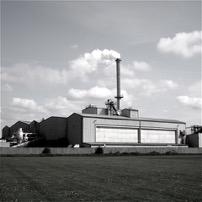How much ‘Better’ can ‘Better Regulation’ get?

Sonae Chipboard plant, Kirkby, Merseyside; after years of controversy over worker health and safety and pollution of the local area, the plant closed in 2012; photograph courtesy of David Jacques.
This week, the Parliamentary Public Accounts Committee published an evaluation of the Better Regulation initiative. The Government, it stated, “has set a target to reduce the cost to business of regulation by £10 billion between 2015 and 2020. So far it has achieved less than £1 billion”. In other words, ‘Better Regulation’ must do better.
Indeed, who could object to ‘Better Regulation’? In a sense, no-one. But the question that has to be asked is what is meant by the term or, indeed, for whom should regulation be better?
A 2005 report – Reducing Administrative Burdens: Effective Inspection and Enforcement – proved to be a turning point in the trajectory of business regulation and enforcement across Britain. It marked the consolidation of the establishment of what had already been termed ‘Better Regulation’, a formal policy shift from enforcement to advice and education, a concentration of formal enforcement resources away from the majority of businesses onto so-called high risk areas, and consistent efforts to do more with less. The Report was the work of Sir Phillip Hampton who was appointed, in 2004, by Chancellor Gordon Brown to oversee a review of a Remit encompassing 63 major regulatory bodies – including the Environment Agency, the Food Standards Agency, the Health and Safety Executive, and the Financial Services Authority – as well as 468 local authorities.
Focusing on three areas of social protection – environmental, food and worker protection – my research indicates clear trends in enforcement practices over the ten-year period since Better Regulation was rolled out. Thus, summarising inspection and enforcement data between 2003/04 and 2014/15, across three regulatory functions overseen by five sets of regulators, I found some stark data.
If we look at food safety and hygiene law, enforced by Local Environmental Health Officers, we see, during this period, that: food hygiene inspections fell by 15%; food standards inspections fell by 35%; food prosecutions fell by 35% .
Turning to pollution control, a function split between the national regulator, the Environment Agency, and local Environmental Health Officers, we find that Environment Agency officers undertook 52% fewer inspections* and 54% fewer successful prosecutions, while issuing 42% fewer cautions. Meanwhile, local Environmental Health Officers enforcing local pollution control law undertook 55% fewer Inspection Visits, while notices issued fell by 30%**.
Finally, examining health and safety law enforcement, inspectors from the Health and Safety Executive, the national health and safety regulator, undertook 69% fewer inspections (on the part of Field Operations Directorate, the body within HSE which undertakes by far the vast majority of inspections) and 35% fewer prosecutions of offences. Local Environmental Health Officers enforcing health and safety law undertook 69% fewer inspections, 96% fewer preventative inspections and 60% fewer prosecutions.
Taken in isolation, perhaps none of this data as it relates to specific enforcement activity on the part of any one regulator is particularly surprising. What is remarkable, certainly for a set of social scientific data, is that each set of data reveals precisely the same trend: that is, notwithstanding variations across regulators, the form of law being enforced, and indeed within regulators and specific forms of enforcement activity by year, each set of data unequivocally indicates a long-term downwards trend in every form of enforcement activity.
Of course, this period, from 2003/04, is also marked by the 2007 financial crisis which was used, by the Coalition Government from 2010 onwards, to justify austerity – so it is likely that within this data there is evidence of both politics and economics at play. And, indeed, ‘austerity effects’ are confirmed if we drill down to local authority level. Thus a case study of five local authorities’ regulatory efforts in these three areas of social protection reveals:
- Considerable reductions in staffing in these regulatory functions
- Declining enforcement activity
- An increasing reluctance to prosecute
- A widespread perception that enforcement capacity has been dangerously undermined.
On the last point, the following quotations, drawn from interviews with EHOs, were typical:
“at present, we can’t meet our statutory duties”
“to be honest we’re now doing statutory stuff only”
“there’s nothing left to cut now”
“there is no padding left, we’re below the statutory minimum … there are no areas of discretion left”
“there’s nothing else to be cut”
“Where we are now, we’re at the point where worker safety is being jeopardized”
“It’s going to come to the point where it going to affect the residents, the local population, in many ways we are at that point now, public health and protection is being eroded”
“We’re at the point where there is no flesh left, this is starting to get dangerous, a danger to public health”
A further, worrying finding from the qualitative research reveals significant push factors towards contracting out or even wholesale privatisation of regulatory services – something which a handful of Local Authorities have now embraced. Taken together, these changes may mark the beginning of the end of the state’s commitment to, and ability to deliver, social protection. Yet this process continues apace, virtually without political, popular nor indeed academic comment. Meanwhile, the Government wants this ‘better regulation’ to get even better. That translates into businesses being freer to flout the law, with workers, consumers and the natural environment less protected than ever.
* This figure refers to the period 1999/00-2008/09; the Environment Agency claimed it could not separate data for inspections to businesses from 2009/10 onwards.
** Notices rather than prosecutions are used, since the latter are so few as to render data almost meaningless.
This blog was originally posted by the Institute of Employment Rights on 14 October 2016 at http://www.ier.org.uk/blog/how-much-better-can-better-regulation-get
Steve Tombs, Professor of Criminology, The Open University
